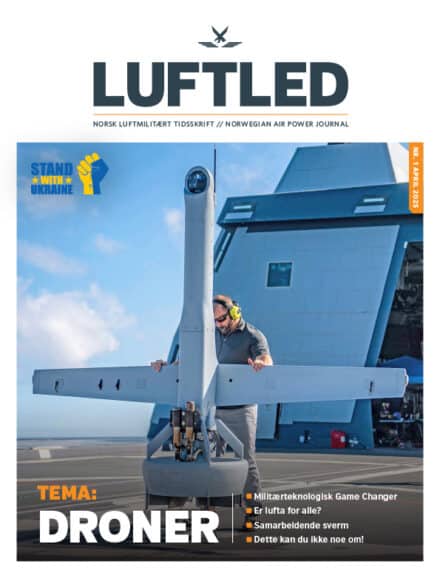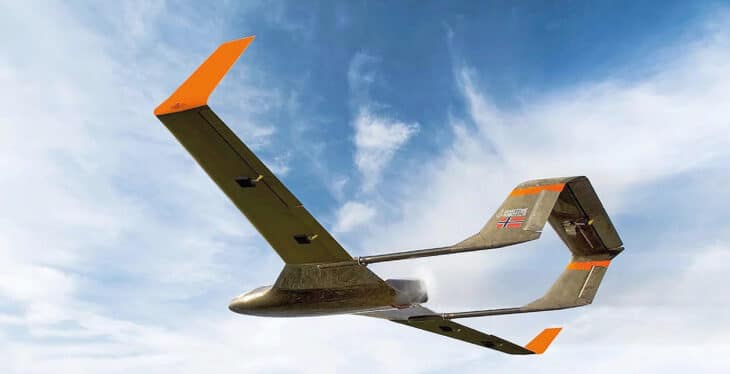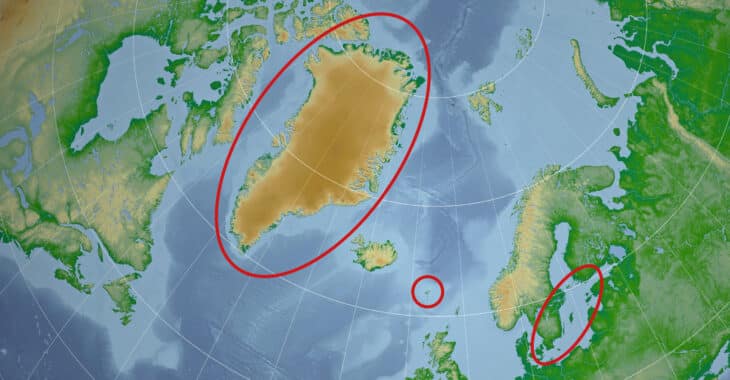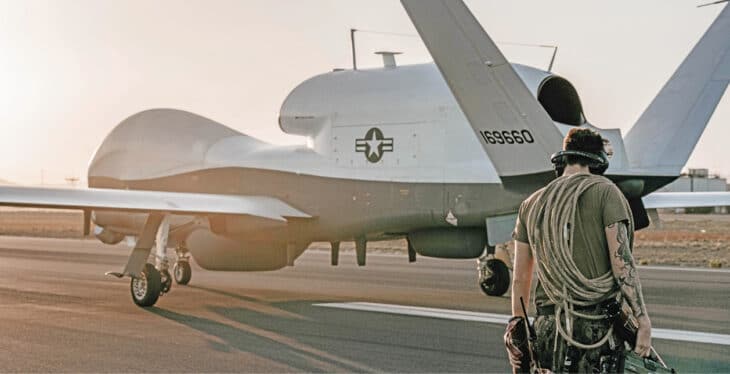A COMBINED NORDIC UAV SQUADRON: – AN OPPORTUNITY WAITING TO BE EXPLORED
The signing of the 2023 Nordic Air Commanders’ Intent, which aims for the Nordic air forces to operate seamlessly together, could mark the start of a deeper Nordic cooperation than we have seen before, at least in the air domain. It could create an opening for all Nordic countries to develop, procure and operate advanced remotely piloted systems.
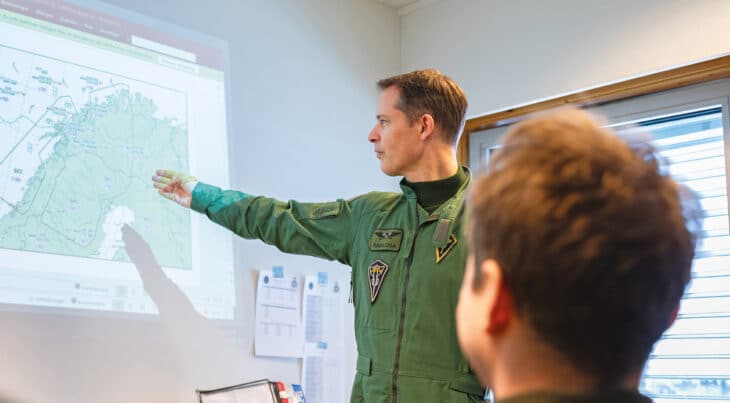
Drones are a subject that has been much debated since the Second Nagorno-Karabakh War. While drones have been used extensively throughout the Global War on Terror era (by states and terrorist groups alike), it seems that most, if not all, countries have been surprised by the capabilities of drones in a war between states. It would seem that “everyone” is now involved in a technological race to augment their military forces with unmanned platforms and robotics of various kinds. The Nordic countries are no exception. However, we face challenges because our nations are small, where demanding priorities affect how much a capability can be brought in without hurting other capabilities. This article highlights how Sweden has used drones, what the future might hold for the Swedish Armed Forces, and how a combined Nordic UAV squadron could be a possible path to gaining capabilities while splitting the costs.
Sweden’s history and future with drones
Sweden started experimenting with unmanned aerial vehicles (UAVs) reasonably early. During the 1970s, the Swedish Defence Research Agency (FOI) began tests with the «Magpie» system (not to be confused with today’s system that bears the same name). During the 1980s, the Swedish army began researching how UAVs could be integrated into an army division intelligence concept to complement conventional reconnaissance. During the 1990s, the army built and conducted tests with various remotely piloted aircraft (including RC model planes). In 1997, the army bought Sperwer, a French system; since then, the Swedish armed forces have had at least six different types of UAVs in service.
The latest tactical-level system bought was the RQ-7 Shadow 200 used by the army. However, remotely piloted aerial systems have been a fringe activity in many ways and have not been entirely accepted as something of value other than abroad during Sweden’s engagement in Afghanistan and Mali. Thus, drone capability has never been widespread throughout the armed forces; instead, it has been concentrated in a few battalions, and usually, there was only one UAV squad per battalion. The head start in the 90s was nullified by years of draw-downs, tight military budgets and preconceptions of what unmanned systems could perform in a peer-to-peer conflict. The war in Ukraine has changed the perspective on the value of drones within the Swedish Armed Forces. Smaller quadcopter platforms are now being distributed throughout the organisation to multiple units regardless of branch or function, tests and evaluations are being conducted with loitering munitions, and Sweden has begun to consider even larger platforms for the future. Today’s overall goal is to profilerate the organisation with small drones that can be used for multiple purposes. Overall, the receptivity for uncrewed platforms seems to have changed on all levels (including the political). With that, resources have been granted to venture into several projects, including swarm technology and cooperation with our Nordic allies.
In a 2018 study, the armed forces proposed that a UAV squadron should be established utilising Medium—or High-Altitude Long-Endurance (MALE/HALE) platforms in 2035. While this proposal never gained much interest, now is the opportunity to venture together, and we, as allies in the «High North,» should consider establishing a combined UAV squadron.
The Nordic cooperation – a solid foundation
Sweden, Norway, Finland, and Denmark have been moving closer to each other for the last decade regarding joint exercises, cross-border training (CBT), and jointly procuring uniforms and weapons, to mention a few examples. However, the signing of the 2023 Nordic Air Commanders’ Intent, which aims for the Nordic air forces to operate seamlessly together, could mark the start of a deeper Nordic cooperation than we have seen before, at least in the air domain. This cooperation could create an opening for all Nordic countries to develop, procure and operate more technologically advanced remotely piloted systems for use in peacetime and war.
Splitting the cost in a joint venture within the Nordic defence cooperation lowers the cost of buying a system and can potentially reduce the cost of training and maintenance
The Swedish government has directed the Swedish Armed Forces to become an observer in the MQ-9B International Cooperative Programme (MICP) and analyse the possibility of establishing a combined Joint Intelligence, Surveillance, and Reconnaissance (JISR) capability with our Nordic neighbours. Denmark and Norway have previously expressed interest in buying a long-range platform like the “Skyguardian”, while Finland has already conducted tests with the MQ-9 Reaper. Although there has been criticism of purchasing MALE/HALE systems due to the vulnerability to surface-to-air missiles, several other European countries have chosen this platform as a persistent surveillance platform capable of detecting land and sea threats. While it is true that platforms like the MQ-9 have had, and still have, challenges in protecting themselves against air defence, we can’t ignore that our foremost adversary, Russia, can still operate its Inhokodets within Russian airspace, observing the Ukrainian advances. Russia also seems to have operated its upcoming UCAV, the S-70 Okhotnik, near contested airspace. As such, I argue that these long-range systems still have a part to play in a future war between nation-states, and disregarding them would be a disservice to the Nordic countries, especially in the future, where the Manned-Unmanned Teaming (MUM-T) is expected to become a reality among several air forces, where the unmanned platform may enhance the survivability of the fighter pilot, either through enhanced situational awareness or by deceiving air defence units. Furthermore, countermeasures are still to become a standard in protecting these platforms in the same manner as the manned platforms.
Our adversaries are very interested in the Arctic, so the Nordic countries have a common interest in surveilling it; covering an area that large consistently requires a combination of assets, not just unmanned platforms. Nevertheless, MALE/HALE platforms provide longevity and critical collection capabilities that complement other sensors. If the intent is to integrate the Nordic air forces, the countries also need to investigate how all countries can utilise these types of platforms in securing the «High North».
Sharing is caring and also a necessity
Sweden and Finland are jointly procuring a tactical unmanned system (TUAS) that could be fielded as early as the half-year mark in 2025. Splitting the cost in a joint venture within the Nordic defence cooperation lowers the cost of buying a system and can potentially reduce the cost of training and maintenance. This joint venture goes beyond financial gains; it paves the road to interoperability where Swedish and Finnish brigades can use drones and artillery interchangeably. It also reveals possibilities for gaining knowledge and sourcing innovation. Additionally, with several allies within NATO procuring the same systems, allies can relieve or support each other with spare parts and form knowledge forums. As such, it would seem logical not only to buy a TUAS but also to go further and jointly buy a MALE/HALE platform.
Operating large aerial systems, manned or unmanned, requires resources. In a time of scarce resources and stretched manning, smaller countries have incentives to jointly procure and staff an unmanned fleet that can be rotated between various airbases in each country. Although the fleet can be rotated between different locations, establishing a combined air operations centre (CAOC) in the north would help fully utilise various air assets (manned or unmanned). This type of infrastructure and personnel pooling is not unheard of within NATO, and it is likely to become more recurrent as the European allies must find ways to build capabilities within the European theatre quickly and efficiently. The Nordic countries have the opportunity to deepen their cooperation with each other within the alliance further and create a combined squadron that can operate in Arctic conditions and act as a sentry in the Baltic Sea with long endurance—as such, creating solid protection of the alliance’s most northern flank.
This article has shown some benefits of creating a combined Nordic UAV squadron focused on conducting operations in northern Europe and the Arctic. Swift decisions and resource allocation are needed to make this a reality. Historically, both the former and the latter have been in short supply. However, with an ongoing war on the European continent and a deteriorating security situation worldwide where Europe is expected to take the lead, I would argue that now is the time to act before the window of opportunity closes.
The views expressed in this article are the author’s views and may not reflect the views of the Swedish armed forces
